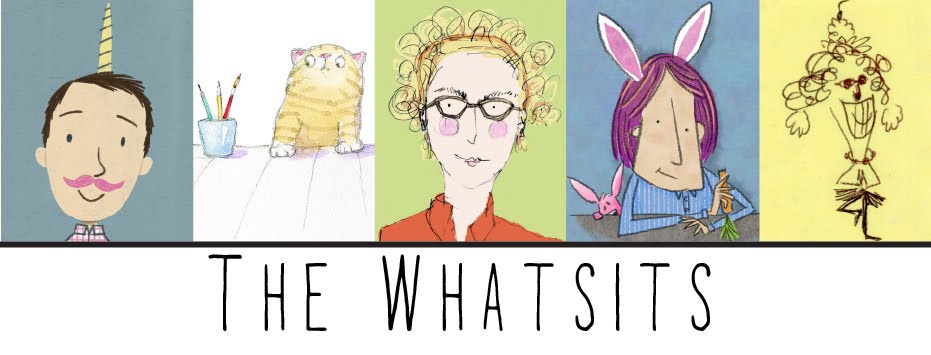Hello! It's Whatsit K. Mann this time. Or Jennifer K. Whatsit, if you prefer.
When it first became clear to me that what I had to do with my life was to become a maker of children’s books, it occurred to me that my learning curve might be kind of steep.
When it first became clear to me that what I had to do with my life was to become a maker of children’s books, it occurred to me that my learning curve might be kind of steep.
My degrees were in history, and then in architecture--not in art or illustration, or writing for children.
And since I was potentially chucking a very decent and happy career as an architect, for something in which I had almost no skills, I knew I had to learn how to do this thing well. But I wasn't going to be heading back to school to do so anytime soon.
And since I was potentially chucking a very decent and happy career as an architect, for something in which I had almost no skills, I knew I had to learn how to do this thing well. But I wasn't going to be heading back to school to do so anytime soon.
What?!
I mean I rounded up a whole
bunch of virtual mentors.
Virtual--as
defined by Mr’s Merriam and Webster-- is “Being such in essence or effect though
not formally recognized as such.”
Mentor--as
defined by Mr’s Merriam and Webster--is “a trusted counselor, or guide.”
My virtual mentors are my trusted counselors or guides. But they are my mentors in essence only. I conjure them in my imagination by learning as much as I possibly can about their work, because I wish they could be my actual, real-life mentors. I can almost hear their voices. But I have only ever met one of them.
They are masters whose wisdom, skill, and knowledge I can solicit whenever I need to get better, go deeper, solve a prickly problem, or be inspired. They stand behind me and direct my work over my shoulder, or scan through my dummies and offer feedback and suggestions for improvement. They do all of this quietly and behind the scenes, and entirely in my mind.
I found my virtual mentors by looking at mountains of picture books.
After a while I noticed there were some books that I kept going back to. I couldn't get enough of the wonderful art, or the touching or funny or totally odd stories.
In order to understand what drew me to those books, I looked very very closely.
I typed the stories out word for word. I read them aloud over and over in various voices to understand the rhythm and word choice. I copied the art. I emulated techniques and styles, and even searched the Internet for interviews and articles that provided insight to how the artists made their unique and sometimes mysterious art.
Occasionally, I found concrete answers. Sometimes I had to guess and experiment myself.
I went over the books I loved the most with a fine toothed comb, and held them almost as close as my nose to analyze brush strokes and tell-tale textures, and discern word choice and structure, or how each scene contributed to the narrative arc.
I learned to look at the copyright page of many picture books for clues the artists sometimes include about their choices of materials and processes.
I drew entire books in thumbnail form in order to analyze pacing and composition and page turns and narrative arcs.
I looked between the lines and underneath the layers of
color and texture for the deeper meaning of what these brilliant people had to
say, and seemed to do so effortlessly.
I learned that none of it is effortless! These authors and illustrators made it look easy, but that was part of the charm of their work. In fact, they had developed their skills through grit and hard work, determination, mastery, and practice.
And as I studied these masters, I was able to find a path to my own voice, my own
style, my own way of making children’s books. By looking closely and analyzing and sometimes mimicking their wonderful work, I absorbed a bit of their wisdom, a few of their skills, insight into their process and point of view. Experimenting with their techniques opened up new ways for me to create my own work.
What a great and important
education.
And it never has to end. I make it a point to read, comb through and analyze mountains of picture books on a regular basis. It's continuing education, and it's cheap, or free, and ultimately priceless.
So, I will send you off to educate yourself with a list of some of my very first virtual mentors. Maybe you can spot their influence in my work. So many more have joined them since I started this most excellent journey (as you can begin to see in the photos above) but these listed below remain my rocks, and I will be forever grateful for all the wisdom and advice they have given me since I started this wonderful pursuit.
Starting with these two:
Although she is neither author nor artist, one of my most important virtual mentors is UrsulaNordstrom. Her incredible wit and wisdom is forever captured in the book of her letters, Dear Genius, The Letters of Ursula Nordstrom, collected and edited by Leonard S. Marcus.
Also, Martin Salisbury, editor of several excellent books about children’s books, and Maria Popova of the excellent blog, Brain Pickings. They are two of my favorite contemporary curators of excellent children’s books. Follow their lead, and you will be educated.
And some of the others, whose work is featured in this post:
That's it for now.
Next up, November 4, will be Kevan Attebury, with a post about doing our work away from the office or studio.
Thanks for visiting, all.
Cheers,
Jen
















































